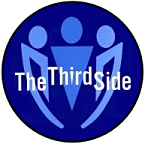The Third Side: Additional Resources for Bridge Builders

| Note Regarding External Links on This Page We are still in the process of converting the "external resource" links from our old computer system to our new one. Unfortunately, this is a time-consuming task which, because of limited funds, we are undertaking on a time-available basis. In the meantime, many of these references can be found by using our Search Plus External Links system. |
Additional Resources for Bridge Builders
Short Examples of Bridge Builders
- Sisterhood Under Fire
- Fish Hooks and Trust
- Seeing Things Differently
- The Role of the Religious Council of Sierra Leone
- Beyond the Abortion Debate - Common Ground
Longer Case Studies of Bridge Builders and other Third Siders in Action
A number of case studies have been developed to exhibit:
- How the third side gets mobilized and becomes active; and
- What the most significant barriers to the third side's emergence are, and why these have proven so difficult to overcome.
These case studies are excellent resources for teachers, study groups, or others interested in the role of the bridge builder (and other third-sider roles) in actual conflict situations.
- Tuzla, The Third Side, and the Bosnian War, by Joshua N. Weiss, Ph.D.
- The Role of Third Side in Peace Talk: Toward Effective Means of Dispute Resolution: The Case of the 1994 Nuclear Crisis between the United States and the DPRK, by Chang In Shin, Ph.D.
- Privatization in Germany: Lessons from a Third Side Case Study, by Mark Young
- "Whose Land Is It Anyway?" The Third Side's Response to Indian Land Claim Conflicts in Upstate New York, by Brian Blancke and Bianca Wulff
- TB in Peru: How the Third Side Mobilized a Global Response to a Burgeoning Health Crisis, by Rebecca J. Wolfe
Internet Resources
- Association for Conflict Resolution - The Association for Conflict Resolution is a merged organization of the Academy of Family Mediators (AFM), the Conflict Resolution Education Network (CREnet) and the Society of Professionals in Dispute Resolution. It is a professional organization dedicated to enhancing the practice and public understanding of conflict resolution.
- European Platform for Conflict Prevention and Transformation - The European Platform for Conflict Prevention and Transformation is a network of European non-governmental organisations involved in the prevention and/or resolution of violent conflicts in the international arena. Its mission is to facilitate the exchange of information and experience among participating organisations, as well as to stimulate co-operation and synergy.
- The Giraffe Project - The Giraffe Project is a story-based curriculum that teaches courageous compassion and active citizenship. It also provides an engaging and effective structure for service-learning, and for meeting community service requirements.
- The Online Healthy Relationships Project - The Online Healthy Relationships Project is an innovative approach to educating adolescents about the underlying issues that contribute to violent behaviour. Essentially a violence-prevention program, the object is to help students learn skills and attitudes needed to build healthy relationships based on sharing power with others. The initiative is a community partnership which derives its strength from the relationship among educators, police, the developers of an acclaimed violence-prevention curriculum and Internet technology specialists.
- PeaceBuilders - PeaceBuilders is a long-term, community-based, violence reduction/crime prevention program. It is a program designed to help create an environment that reduces violence and establishes more peaceful ways of behaving, living and working in families, schools, organizations and communities.
- PeaceNet - PeaceNet is a project of the Institute for Global Communications, and aims to help bring communication technologies to grassroots organizations worldwide working for peace, human rights, environmental sustainability, women's rights, conflict resolution and worker rights. PeaceNet helps connect bridge builders through the world's communications infrastructure.
- Search for Common Ground - Search for Common Ground, founded in 1982, is an international non-governmental organization that works to transform the way the world deals with conflict: away from adversarial approaches, toward cooperative solutions. With programs in or with Angola, Belgium, Burundi, DR Congo, Greece, Indonesia, Iran, Liberia, Macedonia, Middle East, Morocco, Sierra Leone, Turkey, Ukraine, and the United States, our "toolbox" includes mediation/ facilitation training, community organizing, radio/TV, journalism, sports, drama, and music.
Print Resources
- Kelman, H. (1992). "Informal Mediation by the Scholar/Practitioner." In Bercovitch, J. and J. Rubin, eds. Mediation in International Relations. New York: St. Martin's Press. pp. 64-96. - Kelman describes his interactive problem solving approach to conflict resolution. This approach consists primarily of workshops which, "try to contribute to creating a political environment conducive to conflict resolution and to transformation of the relationship between the conflicting parties."[65] Such workshops are intended to supplement and complement official negotiations. - Online Abstract
- Kelman, H.C. (1993). "Coalitions across Conflict Lines: The Interplay of Conflicts within and between the Israeli and Palestinian Communities." In Worshel S. and J. Simpson, eds. Conflict between People and Groups. Chicago: Nelson-Hall.
- Ury, William (2000). The Third Side: Why We Fight and How We Can Stop. New York: Penguin. - This book discusses the "Third Side" within situations of conflict: the human differences that lead to misunderstandings, disagreement, and conflict.
- Ury, William (2001). Must We Fight?: From the Battlefield to the Schoolyard -- A New Perspective on Violent Conflict and its Prevention. New York: John Wiley & Sons. - In this book, the authors provide new research and insights into human behavior and human nature, which show that we are not, in fact, doomed to violent conflict. The book also outlines a brilliant program for personal and community empowerment called The Third Side. This new paradigm shows how we can intervene to support healthy conflict while preventing destructive confrontation.
For More Information
- Where and Why Bridge Builders Are Needed
- Bridge-Building Strategies
- Exercises
- Third Sider Roles
- Main Third Side Page
Much of the material on this user guide is drawn from www.thirdside.org. Thanks to William Ury and Joshua Weiss for giving us permission to republish their material here.







